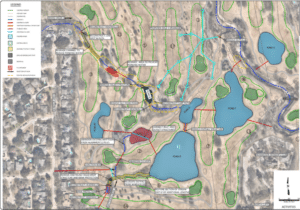Better Golf Through Stream Restoration and Drainage Upgrades
Streams and water hazards are supposed to create challenges on a golf course — but standing water from slow drainage isn’t supposed to make the holes unplayable.

Comprehensive improvements at Sherrill Park Golf Course #2 in Richardson, Texas, have eliminated soggy greens and fairways by using stream restoration, bank stabilization, a reworked storm drain system and even higher cart crossings.
Construction is still underway, but the drainage improvements already have made a difference, quickly draining areas of the course that previously would flood for days even after a small rainstorm. The project encompasses innovative design and reflects the value of long-term partnerships to improve community amenities.
More than two decades ago, Freese and Nichols first helped the City of Richardson address drainage issues on the course. As the city prepared for a redesign in 2021, they partnered with our team again, focusing on needed repairs to address erosion, improve playability and revamp maintenance areas.
A preliminary engineering report identified multiple issues and arranged them in a customized scoring sheet that helped the city prioritize by answering questions about each recommendation such as: How would this make the course more playable for the golfer? What would maintenance look like for this change? What would this cost? How much permitting would be required?
Once the city chose the changes they wanted, our multidisciplinary team from fluvial ecosystem restoration, stormwater and environmental science developed the design.
Choosing the Right Approach
The team paired AutoCAD Civil 3D with Stream Tools, a new software that they were using for the first time. They also applied HEC-RAS 2D modeling to fully understand the hydraulically complex site and develop effective, cost-efficient solutions.

Three different streams flow through the course, with six inline ponds. The modeling led the team to the source of the main drainage problem: Water from one creek would jump its banks and flow overland into a larger creek, flooding areas that took too long to dry out. “Our solution addressed that specifically, and we wouldn’t have been able to see it without that 2D model,” Assistant Project Manager Mason Jones said.
The course’s history, location and water features make it subject to U.S. Army Corps of Engineers jurisdiction, and our environmental science team was instrumental in guiding the project through the permitting process.
Hitting the Sweet Spot
In addition to the innovative application of design tools and methods, the project demonstrated:
- Applying institutional knowledge from previously partnering with the city on course improvements
- Navigating obstacles through our environmental team’s extensive experience with permitting processes
- Extending sustainable practices by using stream restoration to a municipal golf course
This project recently won a Horizon Award, a quarterly award at Freese and Nichols given to projects that encapsulate our culture of innovation.